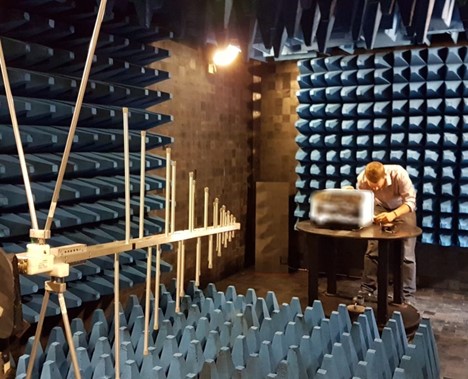Conducted Vs. Radiated Emissions
What is the Difference between Conducted and Radiated Emissions?
Conducted and radiated emissions are distinguished by whether they refer to signals transferred along a cable or through the air.
EMC, or electromagnetic compatibility, refers to a wide range of tests and measurements done to ensure electronic devices function in harmony, without interference from wireless radio communications or by being connected to the same power grid. In this case, conducted and radiated emissions both refer to electromagnetic interference (EMI) emitted from a device. Though EMI is a complex and technical topic, the difference between the two types of emissions is straightforward.
Below is a common example of how conducted emissions testing is set up:

On the flip side, conducted immunity testing simulates various types of power surges to verify devices’ functionality. These surges can be caused by static, indirect lightning, or a voltage dip, so there’s a test standard and a generator for each.
Below is a common setup for radiated emissions testing:

Check out a visual depiction of limit lines from a radiated emissions test below:

The final distinction is that 100% of electronic devices with power sources must undergo conducted emissions testing, while radiated emissions testing is not performed on every device. Many devices do have Wi-Fi, Bluetooth, or other wireless capabilities now, and those must undergo radiated emissions testing. But even in today’s world, these functionalities are not included in every device. On the other hand, all electronic devices (unless purely battery-powered) have a cabled power source, so conducted emissions is mandatory.
Consider a refrigerator. A “smart fridge,” with Wi-Fi capabilities, must undergo radiated emissions and conducted emissions testing. Meanwhile, a regular refrigerator with no Wi-Fi is only connected to the wall outlet and only requires conducted emissions testing.
Though ATEC is not an EMC test lab, we rent equipment that can be used for either pre-compliance or full compliance testing with EMC standards—commercial, automotive, or military/aerospace. Visit What is EMI/EMC Testing? to learn more.
What are Conducted Emissions?
To explain the difference, first we must define the two. Put simply, “conducted” refers to along a cable. Thus, conducted emissions are what signals a device emits, most commonly along a power line to other devices connected to the same power grid. For example, when an electric vehicle is connected to a charging station, the power electronics within the vehicle can generate EMI that may affect the electric vehicle supply equipment nearby. Conducted emissions testing can also be performed along data lines, such as a CAT 6 cable, rather than strictly power lines.Below is a common example of how conducted emissions testing is set up:

Image Source: CUI, Inc. Blog
On the flip side, conducted immunity testing simulates various types of power surges to verify devices’ functionality. These surges can be caused by static, indirect lightning, or a voltage dip, so there’s a test standard and a generator for each.
What are Radiated Emissions?
Radiated emissions are what a device emits in the form of electromagnetic waves through the air. When airlines tell passengers to turn their devices to airplane mode, it’s because the emissions of each phone, tablet, or laptop could interfere with the aircraft’s on-board communication and navigation systems. Likewise, radiated immunity testing ensures the aircraft’s systems can operate in the event of electromagnetic interference.Below is a common setup for radiated emissions testing:

Image Source: James Pawson via Unit 3 Compliance
What are Limit Lines?
Limit lines are the amount of EMI each device can emit. They are specified in emission test standards and generally allow electromagnetic energy to be present up to a certain limit according to frequency range. When performing emissions testing, device emissions must fall below the limit line. Popular emissions test standards by industry are MIL-STD-461 RE102 (Military), RTCA/DO-160 Section 21 (Aerospace), and CISPR 16 (Household/Commercial).Check out a visual depiction of limit lines from a radiated emissions test below:

Image Source: Arturo Mediano via InCompliance Magazine
Additional Examples
One other difference between conducted and radiated emissions lies in the test equipment. To perform conducted emissions testing, a LISN is the key component. It measures the EMI on a cable in conjunction with a spectrum analyzer or EMI receiver. For radiated emissions, an EMC antenna is the key. It measures EMI through the air; and is also used with a spectrum analyzer or EMI receiver.The final distinction is that 100% of electronic devices with power sources must undergo conducted emissions testing, while radiated emissions testing is not performed on every device. Many devices do have Wi-Fi, Bluetooth, or other wireless capabilities now, and those must undergo radiated emissions testing. But even in today’s world, these functionalities are not included in every device. On the other hand, all electronic devices (unless purely battery-powered) have a cabled power source, so conducted emissions is mandatory.
Consider a refrigerator. A “smart fridge,” with Wi-Fi capabilities, must undergo radiated emissions and conducted emissions testing. Meanwhile, a regular refrigerator with no Wi-Fi is only connected to the wall outlet and only requires conducted emissions testing.
Conducted Vs. Radiated
In short, conducted and radiated emissions are both important EMC tests, but they are distinguished by whether they refer to signals transferred along a cable or through the air. When in doubt, remember: Conducted = Cable.Though ATEC is not an EMC test lab, we rent equipment that can be used for either pre-compliance or full compliance testing with EMC standards—commercial, automotive, or military/aerospace. Visit What is EMI/EMC Testing? to learn more.
Posted August 17, 2023
